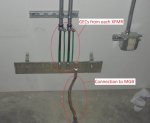This is a thread that was started by another individual under General Electrical that I inquired on. I wanted to bring this to the forefront to see if anyone else has any additional thoughts: https://forums.mikeholt.com/showthread.php?t=197658
My question was in relation to the GEC from a dry-type XFMR, and any allowance for it to be tied to a TMGB in the same room. Again, the TMGB is connected directly back to an MGB located in another room, which then serves as the point of connection for all building electrode connections to meet 250.30(A)(6); the question is with the TMGB connected to the MGB, why would this still not be a suitable point to tie the SDS GEC to given it being the the closest in proximity? What would the difference be by connecting to building steel which would serve as the grounding electrode, instead of the TMGB when both eventually connect back to the MGB?
As referenced by jaggedben, I see that 250.64(C) may be the confirmation that says "NO", but it's hard for me to understand the difference between the two points of connection when both eventually tie back to the MGB. Is the building steel that much better of a point as compared to the TMGB? Is it perhaps means of code enforcement to avoid creating a whole series of ground bars that may or may not tie back to an electrode/MGB? Other reasons?
Thanks.
My question was in relation to the GEC from a dry-type XFMR, and any allowance for it to be tied to a TMGB in the same room. Again, the TMGB is connected directly back to an MGB located in another room, which then serves as the point of connection for all building electrode connections to meet 250.30(A)(6); the question is with the TMGB connected to the MGB, why would this still not be a suitable point to tie the SDS GEC to given it being the the closest in proximity? What would the difference be by connecting to building steel which would serve as the grounding electrode, instead of the TMGB when both eventually connect back to the MGB?
As referenced by jaggedben, I see that 250.64(C) may be the confirmation that says "NO", but it's hard for me to understand the difference between the two points of connection when both eventually tie back to the MGB. Is the building steel that much better of a point as compared to the TMGB? Is it perhaps means of code enforcement to avoid creating a whole series of ground bars that may or may not tie back to an electrode/MGB? Other reasons?
Thanks.


